Walking Holidays in Europe Top 10 Destinations
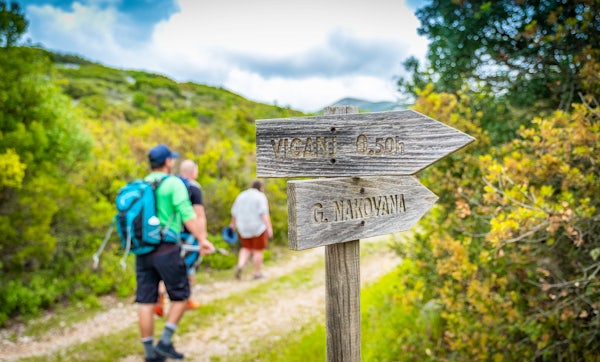
Europe is a veritable crosshatch of hiking routes. From the days of the medieval pilgrims to the gnarly climbs of daring alpinists throughout the 20th century, paths here have been laid and laid again over the course of millennia.
Today, that makes the continent a downright phenomenal place to lace up the boots and hit the trails. But where to go? One standout destination is Croatia, where stunning national parks and breathtaking coastal paths offer a perfect backdrop for active holidays. The country’s diverse landscapes, from rugged mountains to serene waterfalls, invite outdoor enthusiasts to explore its natural beauty.
And for more beyond this horizon, this guide to walking holidays in Europe has you covered, with 10 enticing destinations for all levels of rambler. Let's go…

When to go on a walking holiday in Europe
Spring, summer, and autumn are the top seasons for walking holidays in Europe. Winter can bring snows to the higher trails and close off many of the long-distance routes. Plus, the period between May and October offers way more in the way of sunshine and dry weather. The good thing is that each hiking season has something unique up its sleeve. Let's dig a little deeper…
Spring (March-May)
Europe comes to life after a long winter, so this is high time for seeing the wildflower blooms. They're especially fantastic in the Alps and among the islands of the Adriatic, which get the first sprouts of lavender and snapdragon colouring the hillsides by April. Spring is cooler than summer and less busy, though there might still be some snow at higher levels.
Summer (June-August)
Summer is the most popular time for walking holidays in Europe. From the Greek islands though to the Dinaric Alps of Croatia, the southern half of the continent is blessed with almost ceaseless sun. You'll hike there and then dive into the Aegean or Adriatic Sea to cool off. Hotspots like the Dolomites do get busy and can suffer from sporadic thunderstorms, so consider hiking nearer the coast.
Autumn (September-October)
The finest time of year to plan high-altitude treks and longer walks, Autumn ushers in a mix of lower temperatures and crisp, dry days. The rainfall can tick upwards nearer to November, but September is prime for walking just about everywhere.
Easy hiking destinations
Hvar
Most visitors to the sunniest island in Croatia don't think to peer past the glitzy bars on the main marina of Hvar Town. Behind the rows of glistening yachts there is a rock some 42 miles long and seven miles wide, tufted with hedgerows of aromatic lavender and spotted with ancient farmsteads that have been there since the 2nd century BC!
The 2,500-year-old port of Stari Grad is the perfect base for hiking in these parts. It's the starting point of a loop that will take you 276 meters up onto a ridge of limestone to discover the crumbled pre-historic fort of Purkin Kuk. Afterwards, you can loop back down through forests of Aleppo pines for a reward of ice-cream (or cold Croatian beer) by the Adriatic Sea.

Lake Bled
Clichés aside, Lake Bled really does look like something out of a fairy tale. It sits under the jagged tops of the Julian Alps in northern Slovenia, shimmering an inky blue as an onion-domed church from the 1500s rises on an isle at its centre.
You can stroll the flat path the whole way around the lake for an easy walk of 1.5 hours; it's all paved. Alternatively, more challenging routes beckon in the depths of the Triglav National Park just to the west, including the gravity-defying via ferrata on monstrous Mount Triglav itself.

Mljet
Mljet is the last major Adriatic Island in the south of Croatia. It's also one of the wildest of the bunch. Back in the 1960s, a huge portion of land at the western tip of the isle was designated as a national park, encompassing two green-blue brackish lakes and a wonderful Benedictine monastery from the 12th century.
The proximity to Dubrovnik makes Mljet a popular escape for hikers, particularly since the walking routes are easy-going and accessible. They peak at lookouts 150 meters up and then drop to swimming spots between the spear-like pines. Most walkers choose to stay either on a yacht in a secluded bay or in the bijou port of Pomena, where charming Croatian taverns cluster along the shores.

Medium-level hiking destinations
Zakopane
Hailed as the winter capital of Poland for its abundance of ski fields and ski jumps, Zakopane is no less enticing in the spring and summer months…
Come in April to catch the famous blooms of crocuses turning the surrounding Chochołowska Valley shades of pink and purple. By June, all of the high-altitude trails in the Tatras should be open, which means something for all levels, from the easy route to Morskie Oko (a secret alpine lake under the summit of Poland's highest mountain) to all-day ridge walks along the Slovakian border.

Apuan Alps
Although they share a name with Europe's most iconic mountain chain, the Apuan Alps aren't actually a part of the Alps at all. Instead, they string through the heart of the Apennines in the northernmost portion of Tuscany.
The terrain here oscillates from sylvan valleys flooded with hemlocks and oaks to jagged karst peaks like Pizzo d'Uccello, a great bulwark of limestone some 1,780 meters above the Ligurian Sea. The hiking routes are rarely busy, even in the peak of the summer. Plus, they showcase soaring quarries used for mining Carrara marble – the stone of choice for the Romans!

Advanced hiking destinations
Biokovo Nature Park
The Biokovo Mountain swerves so close to the Adriatic Sea that it seems to lurch vertically out of the water at some points. Thankfully, there's just enough space to fit in the impossibly lovely town of Makarska, where you can hop off a yacht and hit the hiking paths right away.
There are oodles of routes to choose from – the reserve contains over 16 mountains that summit out at more than 1,400 meters, after all. The best of them might just be the thigh-busting path to the top of Mount Vošac. From there, 180-degree panoramas of the glistening Adriatic and the Dalmatian Islands unfold to the west. Back at base level, reward yourself with a dip in the water at pebbly Makarska Beach.
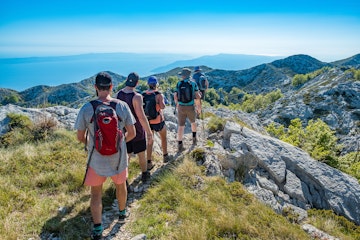
Dolomites
When it comes to walking holidays in Europe, the Dolomites are seriously hallowed ground. This swathe of the eastern Alps crumples and carves its way through the top end of Italy in a symphony of mountains that really need to be seen to be believed. There's the trio of dagger-like spires that is the Tre Cime di Lavaredo. There's the dragon's back of the Seceda Ridge. Amazing one and all.
Hiking in the Dolomites is an adventure you'll never forget. Serious trekkers can embark on long-distance trails like the Alta Via 1, a 10-day traverse across exposed summits and up to high-altitude rifugios. But there are also fantastic day hikes like the up-and-back to milky Lake Sorapis, or a walk in the company of cows on the idyllic pastures of the Alpe di Siusi plateau.
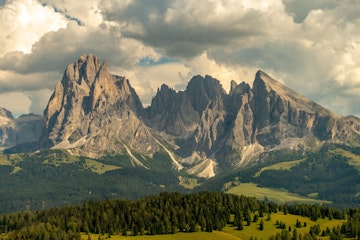
Walking holidays in Europe promise to be some of the most unforgettable walking holidays ever. Seriously, this continent ranges from the jagged Austrian alps to the pine-scented isles of Croatia. So, wax the boots and ready the hiking poles - adventure awaits!
Best National/Nature parks for hiking
Krka National Park
Just a stone's throw away from Sibenik, you’ll find the spectacular and breathtaking landscapes of Krka National Park. A hiker's dream, the park features a network of well-maintained trails that meander through lush forests, alongside sparkling rivers, and past mesmerising waterfalls. Most notable is none other than the iconic Skradinski Buk, which brings crowds from across the globe to come and admire.
Hikers can explore various routes with each offering unique views. Trails vary in difficulty, which caters to those looking for a leisurely stroll or those who are more experienced and are ready for a new challenge!
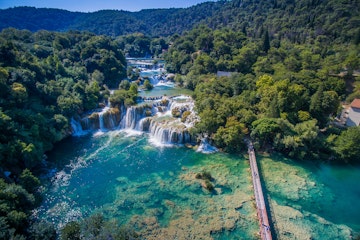
Plitvice Lakes National Park
As a UNESCO World Heritage Site, you can guarantee that this destination is a haven for all. Famous for its cascading lakes and vibrant turquoise waters, Plitvice Lakes National Park offers a series of interconnected trails and wooden boardwalks that allow hikers to seamlessly navigate its unbelievable landscapes. Lush forests surround the area where diverse flora and fauna await making each hike a beautiful journey.
Paths are not too difficult with the most arduous at a moderate level, making it accessible for all skill levels.

Triglav National Park
A Slovenian pride, Triglav National Park is a hiking paradise known for its dramatic mountain landscapes and alpine meadows. Spanning almost 84,000 hectares (or 4% of Slovenian territory), you’ll be hard-pressed not to come across a hiking trail! The park offers a variety of trails that cater to all levels of hikers, with 16 options alone recommended by the park itself.
Whether you’re seeking a challenging ascent or a leisurely wander, the park promises stunning vistas, picturesque valleys, unbelievable views and rewarding experiences. In 2024, it marked the 100-year conservation anniversary to continue preserving this grand and scenic location.
Best Croatian hiking destinations
Istria
On the northwestern edge of Croatia, you’ll find the heart-shaped peninsula of Istria; a picturesque landscape enveloping idyllic villages, diverse landscapes and vivid history. As the largest peninsula in Croatia, Istria has a lot to offer hikers. Its rolling hills, olive groves, and vineyards create a scenic backdrop, whilst charming medieval towns like Motovun; esteemed for its elevation, and Pula; famous for its amphitheatre, provide cultural enrichment along the way.
Ucka Natural Park is a standout gem in Istria and covers an expansive 150 km². With views of the entire peninsula, it’s a top destination for hiking enthusiasts! With steep slopes, stunning waterfalls, and rich biodiversity, Ucka Natural Park offers various hiking trails for all levels of hikers.
Croatian Mountains
Croatia has several notable mountain ranges and over 7,000 named peaks, so you’re not short of a mountain to hike in this country!
Two of Croatia’s leading hiking mountains are Biokovo and Velebit. Velebit is Croatia’s longest mountain range and offers incredibly diverse trails that lead to breathtaking panoramas of the Adriatic Sea and the surrounding horizon. Within Velebit, you’ll also be able to discover the Paklenica National Park which is most notable for its dramatic canyons perfect for hikers interested in discovering more along their way.
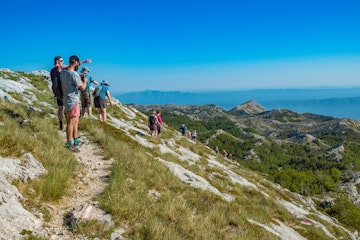
Biokovo is often synonymous with Makarska, serving as a stunning backdrop to this coastal destination. Renowned for its steep limestone cliffs and unique flora, it also boasts the highest peak in Dalmatia, Sveti Jure. Hikers can enjoy breathtaking views from this mountain range, particularly from the Biokovo Skywalk, a half-moon glass walkway that offers an incredible base to look for surrounding islands — and even Italy on a clear day!
Croatian Islands
With over 1,200 islands, islets, and reefs in Croatia, the options for hiking coastal spots are almost endless!
Hvar and Brac however stand out as two of Croatia’s top hiking islands. Hvar, most famous for its super-yachts and celebrity status, wears quite the crown for hiking opportunities. Hvar's town of Stari Grad is home to the island's highest peak on Sveti Nikola; with sea views and coastal paths, it’s definitely a sight for sore eyes! Looking for something more local to Hvar Town? The path up to the Spanjola Fortress will provide views guaranteed to leave you speechless.

Brac, home to the famously voted Zlatni Rat beach, is a hidden haven for hikers. Offering a mix of coastal paths and inland trails that explore the traditional stone villages and stunning viewpoints, uncover the impressive Blaca Hermitage, a jaw-dropping 18th Century Monastery that juts out of a rock face!

Dalmatia
Whilst Croatia offers diverse hiking experiences across its regions, Dalmatia’s combination of coastal beauty, cultural heritage and variety of trails sets it apart as a notable destination for hiking enthusiasts.
Spanning a significant 12,158 km², this region alone features some of Croatia’s most famous national parks from Krka as well as Kornati. Trails in this region range from coastal paths to mountainous terrains and often lead along the Adriatic Coast providing unique views which are limited in other regions. With a more steady climate, Dalmatia generally allows for more pleasant hiking conditions – especially during the warmer months!
Walking holidays in Europe promise to be some of the most unforgettable walking holidays ever. Seriously, this continent ranges from the jagged Austrian Alps to the pine-scented isles of Croatia. If this sounds up your alley, consider looking at our Luxury Hike Cruise or Croatia National Parks Hike Cruise which scratches the itch of island hopping and island exploring on two feet.
So, wax the boots and ready the hiking poles - adventure awaits!

